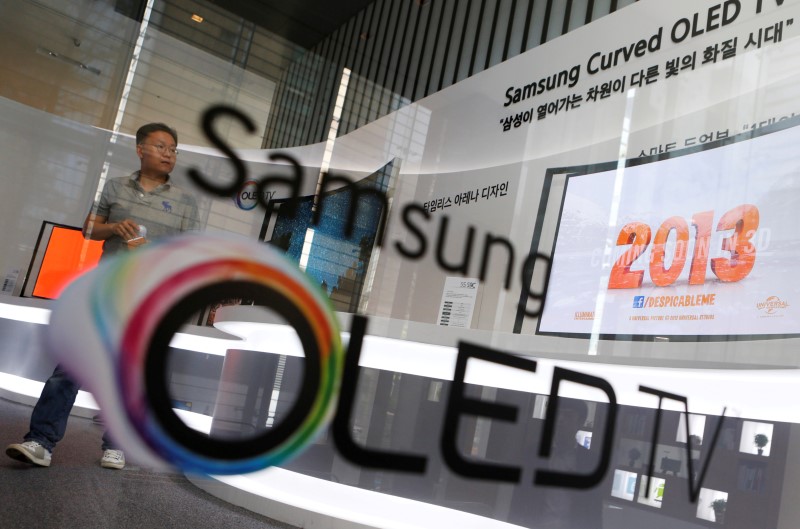By Makiko Yamazaki and Kentaro Hamada
TOKYO (Reuters) – A glimmer of light for Japan’s battered electronics sector: while Sharp Corp <6753.T> and Japan Display Inc <6740.T> lag South Korean rivals in making organic light emitting diode (OLED) screens, some smaller Japanese equipment makers are booming in niche areas further up the OLED manufacturing process.
The shift towards OLED has been prompted mainly by Apple Inc’s <AAPL.O> expected adoption of next-generation OLED technology in its phones as early as next year.
OLED displays are generally thinner and allow more flexibility than liquid crystal display (LCD) screens. Research firm IHS predicts shipments of OLED smartphone panels will overtake LCDs in 2020.
Already, some less well-known Japanese equipment makers including Canon Tokki Corp and Dai Nippon Printing Co <7912.T> have seen strong OLED-related orders from Samsung Display, a unit of Samsung Electronics <005930.KS>, and other global panel makers.
The success of those firms reflects a broader trend in Japan’s consumer electronics sector. Former giants such as Sharp and Sony Corp <6758.T> have struggled against the scale of their Asian rivals, while lesser-known manufacturers have survived by developing niche technologies.
Tokki, a Canon Inc <7751.T> unit which makes vacuum evaporators used in making OLED panels, has an order book of several years, according to industry executives.
CEO Teruhisa Tsugami told Reuters Tokki plans to double production capacity this year to meet strong demand from clients including South Korean, Japanese and Chinese panel makers. “The OLED market is suddenly flourishing on news that Apple is expected to adopt the technology,” Tsugami said.
Tokki has spent years working closely with Samsung to develop equipment best suited for making smartphone panels. Its competitors include South Korea’s SFA Engineering Corp <056190.KQ> and Japan’s Ulvac Inc <6728.T>.
SUPPLY CHAIN
Japanese manufacturers began investing in OLED technology in the 1990s, led by Sony and Pioneer Corp <6773.T>. Most have since given up due to the high costs and defect rates, but smaller equipment makers in the supply chain have kept at it, largely helped by growing sales to Samsung and LG Display <034220.KS>.
“Samsung accounts for roughly 70 percent of orders for those suppliers,” said Hisashi Hattori, OLED consultant at Tokyo-based Analysis Atelier Corp. “The current supply chain has been made for Samsung.”
Dai Nippon Printing has become a leader in producing evaporation masks, used to coat light-emitting materials at precise locations on panels. It said last month it will triple its production capacity by 2020.
“That decision was based on our forecast of growth in the OLED market,” said Mitsuru Tsuchiya, general manager of Dai Nippon Printing’s fine optronics division.
With Sharp and Japan Display as well as Chinese display makers such as BOE Technology Group <000725.SZ> and Tianma Microelectronics <000050.SZ> expanding investment in OLED production, the market is seen growing 16 percent a year to $44 billion by 2020, according to a Markets and Markets report.
Nikon Corp <7731.T> expects orders from global panel makers to drive up shipments of its lithography equipment – which project circuit patterns on to flat panels – by more than three quarters in the year to March.
The firm, better known for its cameras, reckons operating profit this year from flat panel lithography equipment alone will hit 50 billion yen ($472 million), helping offset the impact of weaker camera demand. That’s more than its profit forecast for the overall company.
Shares of Ulvac, which is more exposed to panel equipment manufacturing than other diversified Japanese peers, jumped 64 percent over the past one year, versus a 22 percent decline in the wider market <.N225>.
While the OLED boom is attracting rivals and making competition tougher, Junji Kido, Yamagata University professor and organic electronics expert, said Japan “still has an edge in OLED materials and equipment technologies.”
“It’s such a waste that domestic panel makers have not tapped their technologies.”
(Reporting by Makiko Yamazaki and Kentaro Hamada; Editing by Ian Geoghegan and Miyoung Kim)


